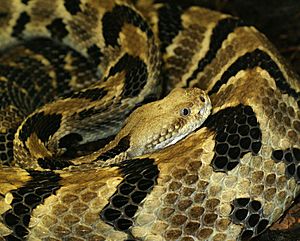Pit vipers facts for kids
Quick facts for kids Pit vipers |
|
|---|---|
 |
|
| Timber rattlesnake, Crotalus horridus | |
| Scientific classification |
|
| Kingdom: | Animalia |
| Phylum: | Chordata |
| Class: | Reptilia |
| Order: | Squamata |
| Suborder: | Serpentes |
| Family: | Viperidae |
| Subfamily: | Crotalinae Oppel, 1811 |
| Synonyms | |
|
|
The Crotalinae, also known as the "pit vipers" or "crotaline snakes", are a subfamily of venomous vipers found in Asia and the Americas.
There are 18 genera and 151 species which are currently found: 7 genera and 54 species in the Old World, and 11 genera and 97 species in the New World. They are the only known vipers found in the Americas. Some of the snakes which belong in this group are the rattlesnakes, lanceheads and Asian pitvipers.
Contents
Description
Pit vipers range in size from the hump-nosed viper, Hypnale hypnale, which grows to the length of around 30–45 centimetres (12–18 in), to the South American bushmaster, Lachesis muta, which is known to grow to a length of 3.65 metres (12.0 ft), making it the longest venomous snake in the New World. Some pit vipers are arboreal (meaning they live in trees), some are terrestrial (meaning they live on the ground), and one species is even semi-aquatic: the cottonmouth, Agkistrodon piscivorus.
Where they live
This subfamily of snakes is found from eastern Europe, eastward through Asia to Japan, Taiwan, Indonesia, India, Nepal and Sri Lanka. In the Americas, they are found from southern Canada, southward to Central America to southern South America. Members of this group are found in deserts and rainforests.
Reproduction
Pit vipers are mainly viviparous, meaning the females give live birth. It is believed that all oviparous Pit vipers guard their eggs. Many young pit vipers have brightly coloured tails which is different to the rest of their body.
Genera
- Moccasins, (Agkistrodon)
- Jumping pitvipers, (Atropoides)
- Palm-pitvipers, (Bothriechis)
- Forest-pitvipers, (Bothriopsis)
- Lanceheads, (Bothrops)
- Malayan pitviper, (Calloselasma)
- Montane pitvipers, (Cerrophidion)
- Rattlesnakes, (Crotalus)
- Hundred-pace pitviper, (Deinagkistrodon)
- Asian moccasins, (Gloydius)
- Hump-nosed pit vipers, (Hypnale)
- Bushmasters, (Lachesis)
- Mexican horned pitvipers, (Ophryacus)
- Mountain pit vipers, (Ovophis)
- Hognose pit vipers, (Porthidium)
- Ground rattlesnakes, (Sistrurus)
- Asian lanceheads, (Trimeresurus)
- Temple vipers, (Tropidolaemus)
See also
 In Spanish: Crotalinae para niños
In Spanish: Crotalinae para niños

